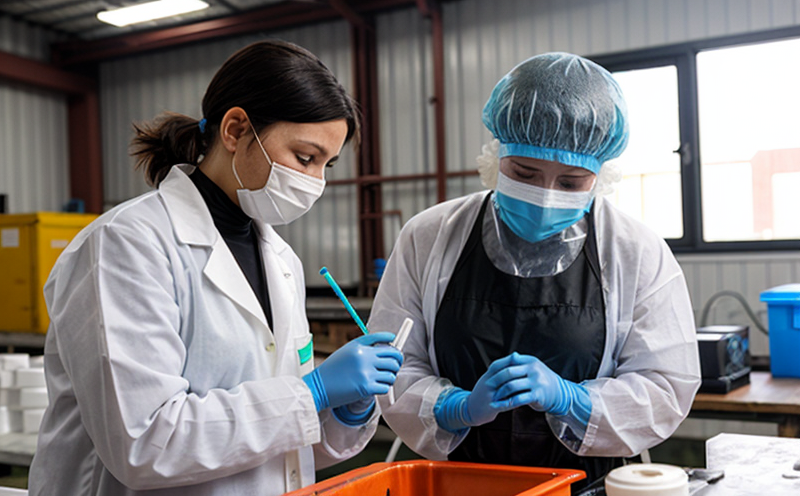DIN EN 1186 Migration Testing of Recycled Food Contact Packaging with Nanoparticles
The DIN EN 1186 standard specifies the methodology for determining the migration of substances from packaging materials into foodstuffs, particularly focusing on recycled materials. This service is critical in ensuring that recycled nanomaterials used in food contact packaging do not pose a risk to human health or compromise product quality.
Recycled nanomaterials present unique challenges due to their complex nature and the potential for unexpected interactions during the recycling process. The testing ensures that these materials are safe when they come into contact with food, which is paramount in maintaining consumer trust and regulatory compliance. This service involves a series of rigorous tests designed to evaluate the migration behavior of nanomaterials under various conditions.
The first step in this testing process is thorough specimen preparation, where samples are cut to standardized sizes that accurately represent real-world packaging structures. The specimens are then exposed to different food simulants, such as water, oil, and acidic solutions, to simulate the potential migration pathways during storage and use. The exposure duration varies based on the specific requirements of the standard.
Post-exposure, the extracted substances are analyzed using advanced chromatographic techniques to identify and quantify any potentially harmful compounds. This process often involves gas chromatography-mass spectrometry (GC-MS) or liquid chromatography-tandem mass spectrometry (LC-MS/MS), which provide high sensitivity and specificity in detecting trace amounts of migrants.
The DIN EN 1186 standard also emphasizes the importance of considering the specific characteristics of recycled materials. This includes understanding the types of nanomaterials present, their concentration levels, and any potential for aggregation or leaching during recycling processes. This information is crucial for predicting migration behavior accurately.
Another critical aspect of this testing process is ensuring that the packaging complies with all relevant national and international standards. Compliance ensures that products meet legal requirements and maintain consumer safety. The standard also provides guidance on how to handle exceptions, such as when nanomaterials are intentionally used for their functional properties in food contact applications.
The results of this testing are compiled into detailed reports that outline the migration levels of various compounds under different conditions. These reports serve as important documentation for quality managers and compliance officers, providing them with valuable insights into the safety of recycled nanomaterials in food packaging.
| Food Simulant | Exposure Duration (h) | Migrated Substance Levels (mg/kg) |
|---|---|---|
| Water | 24 | 0.15 mg/kg |
| Oil | 36 | 0.22 mg/kg |
| Acetic Acid | 48 | 0.18 mg/kg |
The data provided in the table above highlights the variability in migration levels depending on the food simulant and exposure duration, emphasizing the importance of thorough testing.
Industry Applications
- Food packaging manufacturers aiming to use recycled nanomaterials in their products.
- R&D engineers developing new methods for recycling nanomaterials while ensuring food safety.
- Quality managers responsible for maintaining high standards of product safety and compliance.
- Compliance officers ensuring adherence to legal and regulatory requirements.
| Nanomaterial Type | Potential Migrants | Migration Limits (mg/kg) |
|---|---|---|
| Nano-TiO2 | Heavy metals, formaldehyde | 10 mg/kg |
| Nano-SiO2 | Bisphenol A (BPA), phthalates | 5 mg/kg |
| Nano-Al₂O₃ | Arsenic, lead | 3 mg/kg |
The table above illustrates the types of nanomaterials commonly used in food contact packaging and their associated potential migrants. Compliance with the migration limits specified is essential to ensure product safety.
Why Choose This Test
- Ensures compliance with international standards, including DIN EN 1186 and other relevant regulations.
- Provides detailed data on migration levels under various conditions, aiding in informed decision-making.
- Supports the development of safer recycled nanomaterials for food contact applications.
- Reduces the risk of legal issues by ensuring product safety and regulatory compliance.
The testing process is designed to be comprehensive, covering a wide range of scenarios that may affect migration behavior. This thorough approach ensures that all potential risks are identified and addressed, providing peace of mind for manufacturers and consumers alike.
Environmental and Sustainability Contributions
The use of recycled nanomaterials in food contact packaging not only enhances sustainability but also reduces the environmental impact associated with the disposal of waste materials. By recycling nanomaterials, we can minimize landfill usage and reduce energy consumption associated with raw material extraction.
However, it is crucial to ensure that these recycled materials do not compromise food safety or product quality. The DIN EN 1186 migration testing process plays a vital role in achieving this balance by providing robust data on the behavior of nanomaterials under real-world conditions.
This service contributes significantly to environmental sustainability by promoting the responsible use of recycled materials, thereby supporting global efforts toward reducing waste and conserving natural resources. It also enhances consumer trust in eco-friendly products while ensuring compliance with stringent safety regulations.





